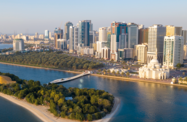The outlook for 2011 is one of correction and consolidation for Sharjah’s real estate sector. The market should slowly start to pick up, though recovery is expected to be modest in the shorter term before gaining momentum.
According to data issued by the Sharjah Real Estate Information Service in mid-November, rental prices had dropped by more than 13% in the first half of 2010, while there had been a 5.5% dip in the cost of buying property between the beginning of January and the end of June.
The agency warned that there could be further declines in both rental returns and sales prices as the market continued to move towards finding its new level. This correction process is likely to be a lengthy one as a number of external factors may have a direct impact on the emirate’s economy and its property market.
One of these factors is the health of Dubai’s economy, which caught a severe chill during the global financial crisis and is still in the process of restructuring and moving towards recovery. With the deflation of the Dubai real estate bubble, prices and rents have tumbled there, and the stock of properties for sale or lease has increased greatly.
In recent years, Sharjah has enjoyed a distinct advantage over its neighbour, with lower rental costs making it an ideal option for commuters looking to work in Dubai but not pay the high prices for property there. This edge is now starting to weaken.
The real estate market has also suffered due to issues with local infrastructure, which lessen its competitiveness with Dubai. Problems in the supply of electricity, for example, saw many regions of the emirate hit by blackouts, especially in the summer months when demand peaked. Bottlenecks in some key road links have also been a problem. In the past, Sharjah’s strong cost advantage meant that commuting residents would overlook such inconveniences, but with Dubai having been brought back to the pack in terms of property prices, potential renters will be looking to compare services as well as cost.
The balance of services should soon shift in Sharjah’s favour, with the state stepping up investments to boost capacity of electricity generation and the distribution grid. Upgrades to roads connecting the emirate with Dubai will further speed commuter traffic and ease congestion.
As well as competition from Dubai, there are also supply issues within Sharjah. The market’s difficulties have been compounded by an oversupply of properties in some segments, with occupancy rates in some newer residential developments running at around 40%. The glut in the market has been fed by the flow of new homes and commercial properties that have become available or are near to completion. Estimates issued last year suggest that up to 7000 new residential units will be added to the market, potentially further exacerbating the issue of oversupply. Work on a number of developments was either put on hold or slowed in 2009 and 2010, but Sharjah’s housing and commercial property stocks are still being added to, albeit at a slower rate compared to 2008.
Yet despite the excess in supply, demand is somewhat restricted, with Sharjah reaffirming its position last year to limit property ownership to nationals and citizens of other GCC states. Sharjah thus has to contend with the competition from Dubai and some other states in the Gulf in the race to attract property investors. The potential pool of investors is limited, though it is still deep enough if developments are marketed to this target group.
While still undergoing a period of adjustment, Sharjah’s property market presents openings for Gulf-based investors. Though listed prices may ease further in the early part of 2011, the correction process is likely coming to an end. For those looking for long-term investment opportunities rather than quick resale options, the coming months could be the time to buy.
Though canny investors have yet to pile into the market, Sharjah is still very much on the radar, according to Ihsan Kharouf, director at the Sharjah office of property firm Cluttons Middle East, especially with buyers from Kuwait and Saudi Arabia.
“The interest is on two levels – as end-users of villas and apartments, especially in Al Nahda and Al Khan – as well as investment interest via the ownership of income-producing properties, especially mid-scale residential buildings,” he told Gulf News in an interview in early January. “The drop in prices is creating added interest but many are adopting a wait-and-see approach at this stage.”
The trick for investors will be to balance the desire to enter the market when prices have bottomed out, while making sure they do not wait too long only to be caught out when the rebound comes into effect. For real estate in Sharjah, it is not just about location but also about timing.

